Introduction to Frontend Frameworks
Frontend frameworks are comprehensive sets of pre-written code, templates, and libraries that offer a structured and standardized approach to constructing user interfaces. Their primary purpose is to simplify the development process by providing reusable components, streamlined workflows, and optimized performance. These frameworks are specifically designed to handle the complexities of contemporary web development, empowering developers to concentrate on crafting interactive and captivating user experiences.
1. Ext JS
Ext JS is a comprehensive JavaScript frontend frameworks that excels in building complex and feature-rich web applications. It offers a vast set of UI components, data-driven architecture, and powerful data manipulation capabilities. Ext JS provides a rich user experience with its customizable themes, responsive design, and extensive documentation. However, it has a steeper learning curve compared to other frameworks.
Benefits of Ext JS:
- A comprehensive collection of UI components, enabling the creation of sophisticated and feature-rich interfaces.
- Robust data handling and manipulation capabilities, empowering seamless management of data in applications.
- Extensive documentation and strong community support, ensure easy adoption and assistance during development.
- Customizable themes and responsive design options, facilitate visually appealing and adaptable user interfaces.
Drawbacks of Ext JS:
- Steeper learning curve compared to some other frontend frameworks, requiring a more significant initial investment of time and effort for developers.
- Commercial licensing is mandatory for commercial projects, potentially adding to the overall development cost.
- Limited integration options with certain other frameworks, which might hinder seamless compatibility with existing tools or technologies.
- Discover the Power of Ext JS Today – Start Your Free Trial!
2. Angular
Angular, developed by Google, is a robust frontend frameworks development that follows a component-based architecture. It provides a robust collection of features and tools for developing dynamic web applications.
Advantages of Angular:
- Two-way data binding streamlines data synchronization between the view and the model, reducing manual handling and enhancing application responsiveness.
- Dependency injection empowers developers to create modular and testable code, facilitating easier maintenance and scalability.
- Extensive documentation and a supportive community offer valuable resources and assistance for developers throughout the development process.
- Built-in support for creating reusable components encourages code reusability, promoting efficient development and reducing redundancy.
Disadvantages of Angular:
- Beginners may face a steeper learning curve due to the frontend frameworks complexity, requiring additional time and effort to grasp its concepts thoroughly.
- The syntax can be complex, and boilerplate code may be necessary, potentially leading to longer development cycles.
- Frequent updates to Angular may demand extra effort to keep up with the latest version, potentially affecting project timelines and resources.
3. React
Advantages of React:
- Utilizes a Virtual DOM, leading to efficient updates and optimized performance by minimizing actual DOM manipulations.
- Promotes development productivity through reusable components, allowing developers to create modular and maintainable code.
- Boasts a large and active community, providing valuable support, knowledge sharing, and continuous development.
- Offers a rich ecosystem with an abundance of third-party libraries and tools, facilitating seamless integration of various functionalities.
Disadvantages of React:
- Beginners may encounter a learning curve, particularly when dealing with JSX syntax, necessitating time and effort to become proficient.
- Lack of built-in support for routing and form validation, requiring developers to rely on additional libraries to implement these functionalities.
- Advanced functionalities may necessitate the incorporation of extra libraries, potentially increasing the project’s complexity and dependencies.
4. Vue.js
Advantages of Vue.js:
- Vue.js boasts a gentle learning curve, making it highly approachable for beginners entering the world of frontend frameworks.
- Its flexibility allows for incremental adoption, enabling developers to integrate Vue.js gradually into existing projects without major disruptions.
- Vue.js offers excellent documentation and enjoys growing community support, providing valuable resources and assistance to developers.
- The frontend frameworks versatility makes it suitable for building applications of various sizes, ranging from small to large-scale projects.
Disadvantages of Vue.js:
- The ecosystem of Vue.js is relatively smaller when compared to more established frameworks like Angular and React, potentially limiting the availability of certain specialized tools or libraries.
- Complex scenarios might have limited resources and documentation, which could pose challenges for developers working on intricate projects.
- In larger applications, performance might be affected, requiring careful optimization and architectural considerations to maintain optimal user experiences.
5. Ember.js
Advantages of Ember.js:
- Ember.js prioritizes convention over configuration, simplifying and standardizing the development process for web applications.
- It offers powerful features like two-way data binding and automatic UI updates, enhancing application responsiveness and user experience.
- Ember.js provides excellent tooling and a positive developer experience, facilitating efficient and productive development workflows.
- The framework benefits from strong community support and active development, ensuring continuous improvement and access to valuable resources.
Disadvantages of Ember.js:
- Ember.js has a steeper learning curve compared to some other frameworks, demanding more time and effort from developers to become proficient.
- The framework offers less flexibility in terms of architectural choices, potentially limiting developers who prefer a more customizable approach.
- Ember.js has seen less adoption in comparison to more popular frameworks like Angular, React, and Vue.js, which could impact the availability of skilled developers and resources in some cases.
6. Bootstrap
Advantages of Bootstrap:
- Bootstrap enables rapid prototyping with its extensive set of ready-to-use components and predefined styles, expediting the development process.
- The responsive grid system simplifies the creation of layouts that adapt seamlessly to different devices, ensuring a mobile-friendly user experience.
- The frontend frameworks benefits from a large and supportive community, providing valuable resources and extensive documentation for developers.
7. Foundation
Advantages of Foundation:
- Foundation is highly customizable, allowing developers to adapt it to various project requirements and design preferences.
- Its mobile-first approach ensures that websites built with Foundation are responsive and optimized for different devices right from the start.
- The frontend framework offers a comprehensive collection of components and plugins, providing developers with a wide range of options to create feature-rich and interactive websites.
Disadvantages of Foundation:
- Foundation may have a steeper learning curve compared to some other frameworks, necessitating more time and effort for developers to become proficient.
- While Foundation enjoys community support, it may not be as extensive as some other well-established frontend frameworks like Bootstrap or React.
- Documentation in certain areas of Foundation could be improved, potentially making it more challenging for developers to find resources and solutions for specific issues.
9. Material-UI
Advantages of Material-UI:
- Material-UI adheres to Google’s Material Design standards, resulting in visually appealing and modern interfaces that follow industry best practices.
- The framework is well-documented and actively maintained, ensuring a stable and reliable development experience for users.
- Material-UI offers an extensive selection of components that come with built-in responsiveness, making it easy to create mobile-friendly and adaptive interfaces.
Disadvantages of Material-UI:
- Material-UI is specific to React, which means developers might need some familiarity with React to make the most of its capabilities.
- Due to the comprehensive collection of components, the bundle size of applications using Material-UI might be heavier, potentially affecting the initial loading time.
- Beginners may face a steep learning curve when using Material-UI, as they would need to grasp both the principles of Material Design and the React framework to leverage its full potential.
10. Bulma
Advantages of Bulma:
Bulma is a lightweight and minimalistic CSS framework, contributing to faster load times and improved website performance.
- Its intuitive syntax makes it easy for developers to learn and use, allowing for a smooth development experience.
- Bulma provides a responsive grid system and a collection of customizable components, enabling developers to create responsive and visually appealing interfaces.
- Built with Sass, Bulma offers flexibility for customization and extension, empowering developers to tailor the framework to suit specific project needs.
Disadvantages of Bulma:
- The community support for Bulma might be smaller compared to some other well-established frameworks, potentially leading to fewer resources and community-contributed components.
- While Bulma offers a collection of UI components, it may have a more limited selection compared to more comprehensive frontend frameworks like Bootstrap.
Conclusion
Finally, the frontend frameworks mentioned in this article provide a variety of features and capabilities, each catering to different web development needs and tastes. Ext JS emerges as a top contender due to its comprehensive feature set, robust architecture, and strong support for enterprise-level applications. It is a fantastic solution for large and complex projects due to its scalability, well-documented resources, and strong capabilities.





